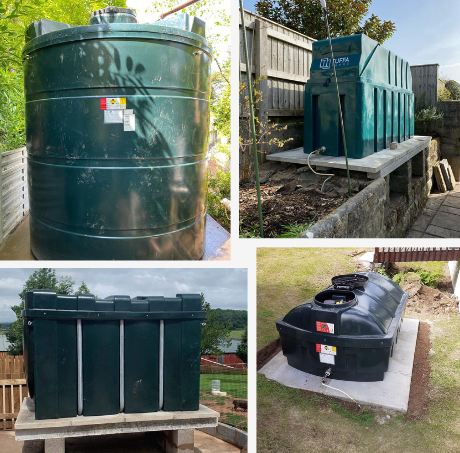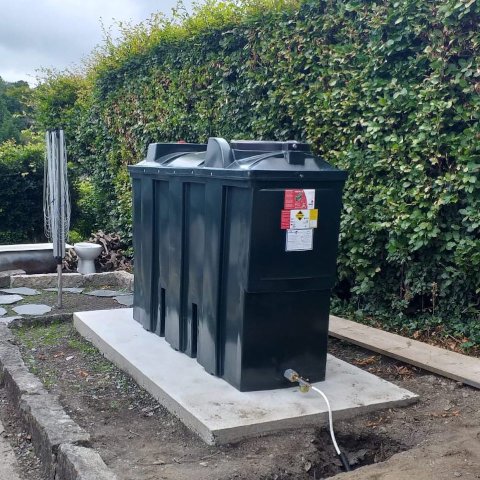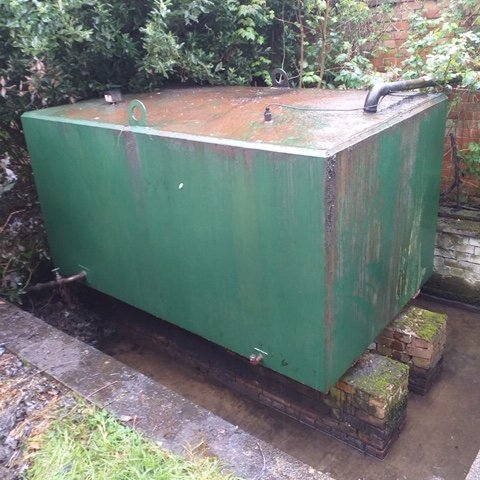What are the Different Types of Oil Tanks
If you rely on oil to heat your home, it is likely at some point that you will need to look at getting a new oil tank installed. It can be hard to know what type of tank to choose.
The tank of choice will ultimately depend on your needs and requirements. To help you make that decision, we’ll take you through the main tank types, common tank materials, and things to consider regarding the size and answer some of the most common questions we get asked.
Regardless of what type of oil tank you choose, it is recommended the tank is manufactured to OFTEC Standards (OFS T100 for plastic or OFS T200 for steel) to ensure the tank complies with the latest environmental and regulation standards.

TYPES OF OIL TANKS
There are a few different structural types of oil storage tanks available, with the most common being single skinned and bunded. We’ll explore these two tank types in more detail, looking at their construction and the pros and cons related to each.
SINGLE SKINNED
A single skin oil tank consists of a single layer of either plastic or steel. This tends to make this tank type the most cost-effective, though also the most vulnerable to damage and corrosion, which in turn causes leaks and spills. As a result, there are additional conditions that need to be met for the installation of a single skin oil tank. In some regions, especially if a controlled water source is nearby, an oil storage tank must be bunded.
Pros:
- Lower initial cost
Cons:
- Vulnerable to damage and corrosion making them prone to leaks and spills
- Subject to additional strict regulations
- Shorter lifespan
- Likely to cost more money in the long run with the need for additional maintenance checks and monitoring
An Oil Storage Risk Assessment would also need to be conducted by an OFTEC-approved engineer before you consider installing a single skin oil tank.
While a single skin tank might look attractive from an initial budget perspective, if you opt for this tank type, you will need to take extra precautions to ensure its safety and longevity, which could prove more costly in the long run.
BUNDED
Bunded oil tanks consist of two layers, with the first internal layer holding the oil and the outer layer acting as a secondary container. This secondary container offers a high level of protection from leaks and spills, making it an industry leader. Bunded oil tanks also come in many different styles and sizes, making them a versatile choice to suit your needs.
Pros:
- Improved protection from leaks and spills
- Longer life span
- Versatile, available in many different styles and sizes
- Improved regulatory compliance
Cons:
- Higher initial cost
Bunded oil storage tanks offer enhanced environmental protection and regulatory compliance, though with a higher initial cost. The long-term benefits in terms of safety, environmental responsibility, and compliance with regulations might offset this initial higher cost.
WHAT ARE THE DIFFERENT MATERIALS OIL TANKS ARE MADE OF
Now that we have looked at the structure of the tanks, let us look in more detail at the typical materials used to create them.
The most common materials for oil storage tanks are plastic and steel. Plastic is typically the most popular, likely due to the potential benefits outweighing the negatives. Both materials have pros and cons. We will go through these in more detail below.
PLASTIC
Plastic oil tanks are the industry standard, especially for domestic storage.
Plastic tanks offer the following benefits:
- Lightweight and affordable
- Resistant to corrosion
- Easy to install
- Comes in a variety of different sizes and styles
- Require less maintenance
- Less prone to leakage
- Durable with a good lifespan
Cons of a plastic tank:
- Less secure from oil theft
With its many benefits, it is no surprise that plastic tanks are a popular choice for domestic heating oil storage.


STEEL
Steel is a traditional choice for oil tanks, and the material lends itself well to the commercial sector as it can accommodate much larger capacities.
Steel tanks offer the following benefits:
- Improved security from oil theft
- Larger capacity
- Great life span when maintained properly
Cons of a steel tank:
- Prone to rust and corrosion if not treated properly
- Prone to splits
- Higher cost of maintenance
- More expensive
While there are benefits to having a steel tank, there are many elements to consider, specifically around the environmental impact and the overall cost and longevity of the tank.
WHAT SIZE TANK DO I NEED
You have chosen the structure and material of your tank: now it is time to look at the various sizes oil storage tanks come in to help you decide which would be best for you.
Domestic oil storage tanks are available in sizes ranging from 500 litres to 10,000 litres. There isn’t a standard size, as it will ultimately come down to your needs.
When making this decision, there are a few things to consider:
- The Number of People – The number of people using the oil for heating and hot water will impact the size and capacity of the tank you need.
- The Number of Rooms – Just as the number of people will play a part, so will the number of rooms you need to heat. A good rule of thumb is to allow for a 500-litre capacity per bedroom with a further 500 litres for other main rooms such as your living room.
- The Location of the Oil Tank – You’ll need to ensure the tank has enough space to comply with current OFTEC regulations. This will impact the size of the tank due to where it will need to sit.
- How Often You Might Need to Refill – If the number of people and rooms means you might need to refill more regularly, and the space allows, a larger capacity tank will reduce refills and potentially be more cost-effective in the long run.
There are a few things to consider, though hopefully, they will help you narrow down your requirements.
Our Oil Tank range is a great place to look to check out different sizes and varieties of tanks.
OIL TANK TYPES FAQs
WHAT IS THE STANDARD SIZE OF AN OIL TANK IN THE UK?
There is no standard oil tank size, though the typical size for UK households is around 1000 to 2500 litres.
HOW LONG WILL 1000 LITRES OF HEATING OIL LAST?
Depending on the number of rooms and the number of people in your property, you can expect 1000 litres of oil to last anywhere from 3 months to 1 year. How long heating oil lasts depends on many factors and is hard to say for certain.
WHERE SHOULD I LOCATE MY OIL TANK?
When it comes to the location of your tank, you should ensure you comply with all current OFTEC regulations.
For the location of an oil tank, OFTEC recommends:
- 1.8m away from non-fire rated eaves of a building
- 1.8m away from a non-fire rated building or structure (e.g. garden sheds)
- 1.8m away from openings (such as doors or windows) in a fire rated building or structure (e.g. brick-built house/garage)
- 1.8m away from liquid fuel appliance flue terminals
- 760mm away from a non-fire rated boundary, such as a wooden boundary fence
- 600mm away from screening (e.g. trellis and foliage) that does not form part of the boundary.
You can find out more by visiting their Home Guide.
An OFTEC registered engineer will be able to advise on the best place for you when they visit your site.

